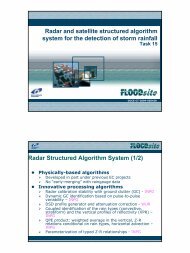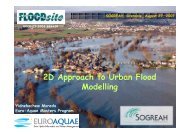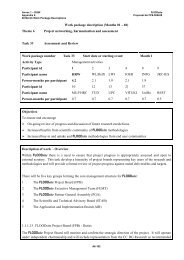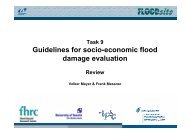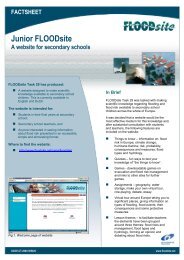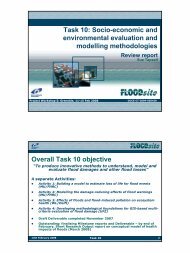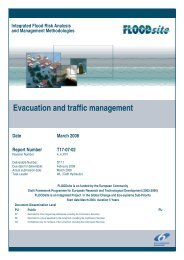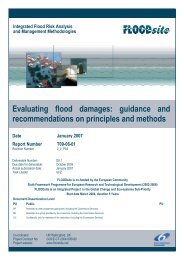Language of Risk - FLOODsite
Language of Risk - FLOODsite
Language of Risk - FLOODsite
You also want an ePaper? Increase the reach of your titles
YUMPU automatically turns print PDFs into web optimized ePapers that Google loves.
<strong>FLOODsite</strong> <strong>Language</strong> <strong>of</strong> <strong>Risk</strong> 2 nd Ed.<br />
Contract No:GOCE-CT-2004-505420<br />
• Probability – can be defined as the chance <strong>of</strong> occurrence <strong>of</strong> one event compared to the population<br />
<strong>of</strong> all events. Therefore, probability is dimensionless – it is however, <strong>of</strong>ten referenced to a specific<br />
time frame, for example, as an annual exceedance probability or lifetime exceedance probability.<br />
• Frequency - defines the expected number <strong>of</strong> occurrences <strong>of</strong> an (particular extreme) event within a<br />
specific number <strong>of</strong> events, <strong>of</strong>ten related to a timeframe (in the case <strong>of</strong> Return Period this is usually<br />
expressed in years).<br />
• Consequence – represents an impact such as economic, social or environmental damage or<br />
improvement, and may be expressed quantitatively (e.g. monetary value), by category (e.g. High,<br />
Medium, Low) or descriptively.<br />
Flooding can have many consequences, some <strong>of</strong> which can be expressed in monetary terms.<br />
Consequences can include fatalities, injuries, damage to property or the environment. Consequences<br />
<strong>of</strong> a defence scheme can include environmental harm or benefit, improved public access and many<br />
others including reduced risk. The issue <strong>of</strong> how some <strong>of</strong> these consequences can be valued continues<br />
to be the subject <strong>of</strong> contemporary research. However, risk-based decision-making would be greatly<br />
simplified if common units <strong>of</strong> consequence could be agreed. It is, therefore, <strong>of</strong>ten better to use<br />
“surrogate” measures or indicators <strong>of</strong> consequence for which data are available. For example,<br />
'Number <strong>of</strong> Properties' may be a reasonable surrogate for the degree <strong>of</strong> harm / significance <strong>of</strong> flooding<br />
and has the advantage <strong>of</strong> being easier to evaluate than, for example economic damage or social impact.<br />
An important part <strong>of</strong> the design <strong>of</strong> a risk assessment method is to decide on how the impacts are to be<br />
evaluated. Some descriptions <strong>of</strong> “consequence” are:<br />
• economic damage (national, community and individual;<br />
• number <strong>of</strong> people /properties affected;<br />
• harm to individuals (fatalities, injury, stress etc);<br />
• environmental and ecological damage (sometimes expressed in monetary terms)<br />
Clearly these differ in what is described.<br />
3.3 How is the significance <strong>of</strong> risk perceived?<br />
Intuitively it may be assumed that risks with the same numerical value have equal ‘significance’ but<br />
this is <strong>of</strong>ten not the case. On the contrary, numerical values play a marginal role in risk perception, as<br />
the term, at least in the traditional approaches to risk perception, refers primarily to everyday<br />
processes by which people estimate risks without utilising statistical series and exact computer<br />
models. It is therefore a “pre-scientific” process, mostly influenced by believes, attitudes, intuition,<br />
expectations, information about and experiences with hazards. For example, the risk perception and,<br />
linked to this, the coping capacities <strong>of</strong> people living in a floodplain with frequent inundation events is<br />
probably higher than <strong>of</strong> those persons who never experienced a flood. However, not only the so-called<br />
“layperson”, also “experts” perceive risk by referring not exclusively to numerical values.<br />
The institutional setting, power relations, preferences and risk attitudes also have an impact on risk<br />
perception and decision behaviour <strong>of</strong> decision-makers. Thus the primary aim investigating risk<br />
perception by means <strong>of</strong> quantitative and qualitative social science survey techniques is<br />
• to understand and anticipate public responses to hazards,<br />
• to improve the communication <strong>of</strong> information about the hazard both on the side <strong>of</strong> laypersons and<br />
experts and<br />
• to identify the most relevant criteria to assess risk situations.<br />
On basis <strong>of</strong> risk perception studies strategies <strong>of</strong> information and communication can possibly be<br />
improved and flood mitigation measures can be better assessed.<br />
T32_04_01_ <strong>FLOODsite</strong>_<strong>Language</strong>_<strong>of</strong>_<strong>Risk</strong>_D32_2_v5_2_P1 30 April 2009<br />
6



